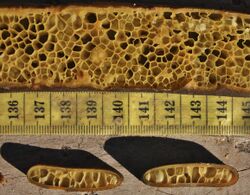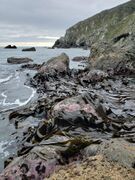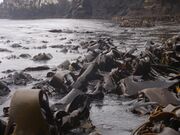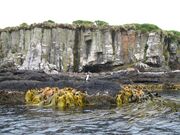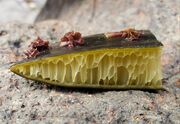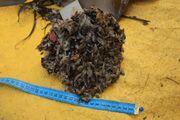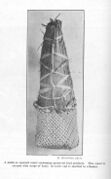Biology:Durvillaea
| Durvillaea | |
|---|---|
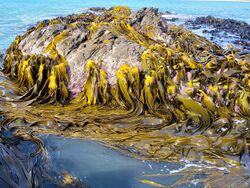
| |
| Durvillaea antarctica and D. willana on Taieri Island | |
| Scientific classification | |
| Domain: | Eukaryota |
| Clade: | Diaphoretickes |
| Clade: | SAR |
| Clade: | Stramenopiles |
| Phylum: | Gyrista |
| Subphylum: | Ochrophytina |
| Class: | Phaeophyceae |
| Order: | Fucales |
| Family: | Durvillaeaceae (Oltmanns) De Toni |
| Genus: | Durvillaea Bory |
| Type species | |
| D. antarctica | |
| Species | |
|
See text | |
Durvillaea is a genus of large brown algae in the monotypic family Durvillaeaceae. All members of the genus are found in the southern hemisphere, including Australia , New Zealand, South America, and various subantarctic islands.[2][3] Durvillaea, commonly known as southern bull kelps, occur on rocky, wave-exposed shorelines and provide a habitat for numerous intertidal organisms.[4][5] Many species exhibit a honeycomb-like structure in their fronds that provides buoyancy, which allows individuals detached from substrates to raft alive at sea, permitting dispersal for hundreds of days over thousands of kilometres.[3][6][7] Durvillaea species have been used for clothing, tools and as a food source by many indigenous cultures throughout the South Pacific, and they continue to play a prominent role in Chilean cuisine.[3]
Common name and etymology
The common name for Durvillaea is southern bull kelp, although this is often shortened to bull kelp, which can generate confusion with the North Pacific kelp species Nereocystis luetkeana.[8][9]
The genus is named after French explorer Jules Dumont d'Urville (1790-1842).[10]
Description
Durvillaea species are characterised by their prolific growth and plastic morphology.[11]
Two species, D. antarctica and D. poha are buoyant due to a honeycomb-like structure in the fronds of the kelp that holds air.[3][12] When these species detach from the seabed, this buoyancy allows for individuals to drift for substantial distances, permitting long distance dispersal.[3][13] In contrast, species as D. willana lack such 'honeycomb' tissue and are non-buoyant, preventing the individuals from moving long distances.[13]
Ecology
Durvillaea bull kelp grow within intertidal and shallow subtidal areas, typically on rocky wave-exposed coastal sites.[11] D. antarctica and D. poha are intertidal, whereas D. willana is subtidal (to 6 m depths).[14] Intertidal species can grow at the uppermost limit of the intertidal zone if there is sufficient wave wash.[15] Species can withstand a high level of disturbance from wave action,[11] although storms can remove individuals from substrates.[16][17][18]
- D. antarctica growing at Boom Rock, Wellington
- D. antarctica at Manurewa Point, in the Wairarapa
- D. fenestrata growing in the Antipodes Islands
Epibionts, parasites and rafting

Holdfasts of D. antarctica and other species are often inhabited by a diverse array of epifaunal and infaunal invertebrates, many of which burrow into and graze on the kelp.[4][5] In New Zealand, species that inhabit Durvillaea include the sea-star Anasterias suteri, crustaceans such as Parawaldeckia kidderi, P. karaka,[5] and the gribbles Limnoria segnis[5] and L. stephenseni, as well as the molluscs Cantharidus roseus, Onchidella marginata,[19] Onithochiton neglectus,[20][5] and Sypharochiton sinclairi,[16][17][18] and the spider Desis marina.[21][22]
Durvillaea individuals can detach from substrates, particularly during storms. Once detached, buoyant species such as D. antarctica and D. poha can float as rafts, and can travel vast distances at sea, driven by ocean currents.[6][7] Specimens of D. antarctica have been found to float for up to 210 days, during which time high wind speeds transport kelp rafts up to 10,000 km.[6][7] Environmental factors such as temperature, solar radiation and surface winds (all of which vary with latitude) affect buoyancy of southern bull kelp rafts and their rate of travel.[6] Rafts of D. antarctica are more likely to disperse offshore if individuals detach during outgoing tides during autumn and winter.[23] Rafts of Kelp-associated invertebrates can be transported inside of drifting kelp holdfasts, potentially leading to long-distance dispersal and a significant impact upon the population genetic structure of the invertebrate species.[16][17][18][19][20]
Rafts of Durvillaea can be colonised by the goose barnacles Lepas australis and L. pectinata. Beachcast, decomposing bull-kelp is colonised and consumed by a wide variety of invertebrates including sandhoppers Bellorchestia quoyana,[24] and kelp flies Chaetocoelopa littoralis.
Other seaweeds including Gelidium lingulatum, G. rex, Corallina officinalis var. chilensis, and Lessonia spicata also grow as epiphytes in the holdfasts of D. antarctica.[25] Rafting on D. antarctica appears to have influenced the dispersal and phylogeography of these non-buoyant species.[25][26] In New Zealand, Durvillaea fronds can also be infected by the obligate red algal epiphyte Pyrophyllon subtumens (J. Agardh ex R.M. Laing) W.A. Nelson 2003.[27][28]
Fronds of D. antarctica can be infected by an endophytic, phaeophycean algal parasite Herpodiscus durvillaeae (Lindauer) G.R. South.[29][30] Fronds can also be infected Maullinia, a genus of intracellular, protistan parasites.[31][32][33] Based on genetic evidence, both H. durvillaeae and Maullinia have likely been dispersed across the Southern Hemisphere via rafting bull kelp.[30][31][33][34]
- Cross-section of a D. antarctica frond, showing Pyrophyllon subtumens growing on the outer surface
Environmental stressors
Increased temperatures and heatwaves, increased sedimentation, and invasive species (such as Undaria pinnatifida) are sources of physiological stress and disturbance for members of the genus.[35]
A marine heatwave in the summer of 2017/18 appears to have caused the local extinction of multiple Durvillaea species at Pile Bay, on the Banks Peninsula.[36] Once the kelp was extirpated, the invasive kelp Undaria pinnatifida recruited in high densities.[36]
Disturbance from earthquake uplift
Earthquake uplift that raises the intertidal zone by as little as 1.5 metres can cause Durvillaea bull kelp to die off in large numbers.[13][37][38] Increased sedimentation following landslides caused by earthquakes is also detrimental.[37][38] Once an area is cleared of Durvillaea following an uplift event, the bull kelp that re-colonises the area can potentially originate from genetically distinct populations far outside the uplift zone, spread via long distance-dispersal.[39]
Intertidal species of Durvillaea can be used to estimate earthquake uplift height, with comparable results to traditional methods such as lidar.[15] However, since Durvillaea holdfasts often grow at the uppermost limit of the intertidal zone, these uplift estimates are slightly less accurate compared to measures derived from other intertidal kelp such as Carpophyllum maschalocarpum.[15]
Chile
The 2010 Chile earthquake caused significant coastal uplift (~0.2 to 3.1 m), particularly around the Gulf of Arauco, Santa María Island and the Bay of Concepción.[40] This uplift caused large scale die offs of D. antarctica and dramatically affected the intertidal community.[40] The damage to infrastructure and ecological disturbance caused by the earthquake was assessed to be particularly damaging for seaweed gatherers and cochayuyo harvest.[41]
New Zealand
Akatore
Duvillaea bull kelp diversity appears to have been affected by uplift along the Akatore fault zone. Phylogeographic analyses using mitochondrial COX1 sequence data and genotyping by sequencing data for thousands of anonymous nuclear loci, indicate that a historic uplift event (800 – 1400 years before present) along the fault zone and subsequent recolonisation, has left a lasting impact upon the genetic diversity of the intertidal species D. antarctica and D. poha, but not on the subtidal species D. willana.[14][42] Such a genetic impact may support the founder takes all hypothesis.[14][42] Further genetic analysis has revealed that the population structure of two epifaunal species, the gribble L. segnis and the chiton O. neglectus, closely matches the pattern observed in the intertidal host species of Durvillaea along the Akatore fault zone.[5] However, no matching pattern was observed for another epifaunal species, the amphipod P. karaka, most likely because this species has better swimming potential and can rely upon other host seaweeds.[5]
Kaikoura
A substantial die off of Durvillaea bull kelp occurred along the Kaikoura coastline following the 2016 Kaikoura earthquake, which caused uplift up to 6 metres.[15][4][37][38][39] The loss of Durvillaea kelp caused ecological disturbance, significantly affecting the biodiversity of the local intertidal community.[37][38] Aerial drone imaging two years after the earthquake indicated that Durvillaea abundance remained low on reefs with significant uplift, but it revealed offshore refuge populations less frequently detected by field researchers.[43] A genetic analysis indicated that some of the Durvillaea that subsequently reached the affected coastline (i.e. potential colonists) came from areas >1,200 kilometres away.[39]
Rārangi
The D. antarctica sampled from Rarangi, near Blenheim in Marlborough has been found to be genetically distinct from nearby geographic populations, and the kelp is most closely related to D. antarctica populations sampled over 300 km to the south on Banks Peninsula.[44] Independently, based on LiDAR mapping and field observations, geologists have discovered a zone of uplifted rocky coastline at the same location.[44] By combining the above genomic and geological evidence, researchers have hypothesised that a small section of coastline at Rarangi was uplifted by one of four major earthquakes between 6000 and 2000 years ago, which was sufficient in height and sudden enough to extirpate the original population of D. antarctica.[44] Under this hypothesis, the present-day population was founded by rafts of kelp that were not related to the nearby geographic populations, leading the to current genetically distinct population present at Rarangi.[44]
Wellington and the Wairarapa
Based on genetic data, the predominantly southern-restricted species D. poha appears to have undergone a recent range expansion into the North Island, as it can be found at low frequencies along the Wellington coastline.[45] This range expansion coincides with areas affected by tectonic uplift and landslides caused by historic earthquakes, including the 1855 Wairarapa earthquake.[45] The removal of D. antarctica and formation of new coastline by such tectonic disturbance likely provided an ecological opportunity for D. poha to successfully colonise coastline north of the Cook Strait.[45]
A genetic study of D. antarctica identified distinct units of population structure across the uplift zone of the 1855 Wairarapa earthquake.[46] Notably, two spatial-genomic sectors of D. antarctica were identified on Turakirae Head, which received the greatest degree of uplift (2 – 6 m).[46] Phylogeographic modelling indicated that bull kelp that survived moderate uplift in the Wellington region (≤2 m) likely recolonised Turakirae Head via two parallel, eastward colonisation events - resulting in the two observed units of population structure.[46] The hierarchical phylogeographic variation observed in the study provided non-experimental evidence of parapatric sectoring (see Founder takes all) as a result of natural disturbance, over a timescale observable to humans (i.e. <200 years).[46]
It has been hypothesised that gaps in the current geographic range of D. willana around Wellington and the Wairarapa may have been caused by local extinction following historic earthquake uplift events such as the 1855 Wairarapa earthquake.[13] However, uplift along the Akatore fault zone does not appear to have significantly affected the genetic diversity of D. willana in that region.[14] The interpretation of this genetic result for Akatore was that earthquake uplift is likely insufficient to cause the complete extirpation of subtidal kelp species such as D. willana.[14]
Species and distribution
There are currently eight recognised species within the genus, and the type species is D. antarctica.[1] All species are restricted to the Southern Hemisphere and many taxa are endemic to particular coastlines or subantarctic islands.
- Durvillaea amatheiae X.A. Weber, G.J. Edgar, S.C. Banks, J.M. Waters & C.I. Fraser, 2017,[47] endemic to southeast Australia.[3][47]
- Durvillaea antarctica (Chamisso) Hariot,[1] found in New Zealand, Chile and various subantarctic islands including Macquarie Island.[2][24][3][9][11][12][42][44][46][48][49]
- Durvillaea chathamensis C.H.Hay, 1979,[49] endemic to the Chatham Islands.[3][9]
- Durvillaea fenestrata C. Hay, 2019,[3] endemic in the subantarctic Antipodes Islands.[3][9]
- Durvillaea incurvata (Suhr) Macaya,[3] endemic to Chile.[3]
- Durvillaea poha C.I. Fraser, H.G. Spencer & J.M. Waters, 2012,[12] endemic to South Island of New Zealand, as well as the subantarctic Snares and Auckland Islands.[3][9][12][48]
- Durvillaea potatorum (Labillardière) Areschoug, endemic to southeast Australia.[8][9][50]
- Durvillaea willana Lindauer, 1949,[51] endemic to New Zealand.[2][3][9][13][49][51]
Evolution
Time-calibrated phylogenetic trees using mixtures of mitochondrial and nuclear DNA markers have estimated that Durvillaea diverged from other brown algae approximately 20 to 60 million years ago.[9][52] Given the modern distribution of extant Durvillaea species throughout the Southern Ocean, it has been suggested that the distribution may reflect vicariance following the break-up of Gondwana 40 to 50 million years ago, but this distribution can also be explained by the long-distance dispersal of buoyant Durvillaea lineages throughout the Southern Ocean.[9][53] Based on molecular phylogenetic research, non-buoyancy is not necessarily the ancestral state for the genus,[3][9] and non-buoyant lineages could have still been transported across the ocean when attached to rafts of different species of buoyant algae.[9]
A phylogeny focused on the genus, based on four genes (COI, rbcL, 28S and 18S) indicates the evolutionary relationships shown in the cladogram below.[3][9] Notably, additional unclassified lineages were estimated within D. antarctica.[3][9] Mitochondrial introgression has been observed between two species, where some individuals with nuclear DNA of D. poha exhibited mitochondrial DNA belonging to D. antarctica.[45]
Script error: No such module "Clade/gallery".
Use of Durvillaea species
Australia
D. potatorum was used extensively for clothing and tools by Aboriginal Tasmanians, with uses including material for shoes and bags to transport freshwater and food.[54][55] Currently, D. potatorum is collected as beach wrack from King Island, where it is then dried as chips and sent to Scotland for phycocolloid extraction.[56]
Chile
D. antarctica and D. incurvata have been used in Chilean cuisine for salads and stews, predominantly by the Mapuche indigenous people who refer to it as collofe or kollof.[3][57] The same species is also called cochayuyo (cocha: lake, and yuyo: weed), and hulte in Quechua.[3][41][58] The kelp harvest, complemented with shellfish gathering, supports artisanal fishing communities in Chile.[58] Exclusive harvest rights are designated using coves or caletas, and the income for fishers (and their unions) often depends upon the sale of cochayuyo.[58]
New Zealand
Māori use D. antarctica (rimurapa) and D. poha to make traditional pōhā bags, which are used to transport food and fresh water, to propagate live shellfish, and to make clothing and equipment for sports.[59][60][61] Pōhā are especially associated with Ngāi Tahu and are often used to carry and store muttonbird (tītī) chicks.[59][60] The Ngai Tahu Claims Settlement Act 1998 protects Durvillaea bull kelp from commercial harvesting within the tribe's traditional seaweed-gathering areas.[62]
People living in coastal Otago and Southland have also traditionally carved bouncing balls, including cricket balls, out of the solid stipes of Durvillaea.[63][64]
- Cochayuyo (D. antarctica) for sale in Chile
References
- ↑ 1.0 1.1 1.2 Bory de Saint-Vincent, J.B.G.M. (1826). Laminaire, Laminaria. In: Dictionnaire Classique d'Histoire Naturelle. (Audouin, I. et al. Eds) Vol. 9, pp. 187-194.
- ↑ 2.0 2.1 2.2 Hay, Cameron H. (1977). A biological study of Durvillaea antarctica (Chamisso) Hariot and D. willana Lindauer in New Zealand (Doctor of Philosophy thesis). University of Canterbury. hdl:10092/5690.
- ↑ 3.00 3.01 3.02 3.03 3.04 3.05 3.06 3.07 3.08 3.09 3.10 3.11 3.12 3.13 3.14 3.15 3.16 3.17 3.18 Fraser, Ceridwen I.; Velásquez, Marcel; Nelson, Wendy A.; Macaya, Erasmo C.A.; Hay, Cameron (2019). "The biogeographic importance of buoyancy in macroalgae: a case study of the southern bull‐kelp genus Durvillaea (Phaeophyceae), including descriptions of two new species". Journal of Phycology 56 (1): 23–36. doi:10.1111/jpy.12939. PMID 31642057.
- ↑ 4.0 4.1 4.2 Luca, Mondardini (2018). Effect of earthquake and storm disturbances on bull kelp (Durvillaea ssp.) and analyses of holdfast invertebrate communities (Master of Science in Environmental Sciences thesis). University of Canterbury. hdl:10092/15095.
- ↑ 5.0 5.1 5.2 5.3 5.4 5.5 5.6 Parvizi, Elahe; Dutoit, Ludovic; Fraser, Ceridwen I.; Craw, Dave; Waters, Jonathan M. (2022). "Concordant phylogeographic responses to large-scale coastal disturbance in intertidal macroalgae and their epibiota". Molecular Ecology 31 (2): 646–657. doi:10.1111/mec.16245. PMID 34695264.
- ↑ 6.0 6.1 6.2 6.3 Tala, Fadia; López, Boris A.; Velásquez, Marcel; Jeldres, Ricardo; Macaya, Erasmo C.; Mansilla, Andrés; Ojeda, Jaime; Thiel, Martin (2019). "Long-term persistence of the floating bull kelp Durvillaea antarctica from the South-East Pacific: Potential contribution to local and transoceanic connectivity". Marine Environmental Research 149: 67–79. doi:10.1016/j.marenvres.2019.05.013. PMID 31154063. Bibcode: 2019MarER.149...67T.
- ↑ 7.0 7.1 7.2 Fraser, Ceridwen I.; Dutoit, Ludovic; Morrison, Adele K.; Pardo, Luis Miguel; Smith, Stephen D.A.; Pearman, William S.; Parvizi, Elahe; Waters, Jonathan et al. (2022). "Southern Hemisphere coasts are biologically connected by frequent, long-distance rafting events". Current Biology 32 (14): 3154–3160.e3. doi:10.1016/j.cub.2022.05.035. PMID 35679870.
- ↑ 8.0 8.1 Cheshire, A.C.; Hallam, N. (2009). "Morphological Differences in the Southern Bull-Kelp (Durvillaea potatorum) throughout South-Eastern Australia". Botanica Marina 32 (3): 191–198. doi:10.1515/botm.1989.32.3.191.
- ↑ 9.00 9.01 9.02 9.03 9.04 9.05 9.06 9.07 9.08 9.09 9.10 9.11 9.12 Fraser, C.I.; Winter, D.J.; Spencer, H.G.; Waters, J.M. (2010). "Multigene phylogeny of the southern bull-kelp genus Durvillaea (Phaeophyceae: Fucales)". Molecular Phylogenetics and Evolution 57 (3): 1301–11. doi:10.1016/j.ympev.2010.10.011. PMID 20971197.
- ↑ M. Huisman, John (2000). Marine Plants of Australia. University of Western Australia Press. p. 212. ISBN 978-1-876268-33-6.
- ↑ 11.0 11.1 11.2 11.3 "Kelp". Department of the Environment and Energy. http://www.antarctica.gov.au/about-antarctica/wildlife/plants/kelp.
- ↑ 12.0 12.1 12.2 12.3 Fraser, Ceridwen I.; Spencer, Hamish G.; Waters, Jonathan M. (2012). "Durvillaea poha sp. nov. (Fucales, Phaeophyceae): a buoyant southern bull-kelp species endemic to New Zealand". Phycologia 51 (2): 151–156. doi:10.2216/11-47.1.
- ↑ 13.0 13.1 13.2 13.3 13.4 Hay, Cameron H. (2019). "Seashore uplift and the distribution of the bull kelp Durvillaea willana Lindauer in New Zealand". New Zealand Journal of Botany 2019 (2): 94–117. doi:10.1080/0028825X.2019.1679842.
- ↑ 14.0 14.1 14.2 14.3 14.4 Parvizi, Elahe; Fraser, Ceridwen I.; Dutoit, Ludovic; Craw, Dave; Waters, Jonathan M. (2020). "The genomic footprint of coastal earthquake uplift". Proceedings of the Royal Society B 287 (1930): 20200712. doi:10.1098/rspb.2020.0712. PMID 32635859.
- ↑ 15.0 15.1 15.2 15.3 Reid, Catherine; Begg, John; Mouslopoulou, Vasiliki; Oncken, Onno; Nicol, Andrew; Kufner, Sofia-Katerina (2020). "Using a calibrated upper living position of marine biota to calculate coseismic uplift: a case study of the 2016 Kaikoura earthquake, New Zealand". Earth Surface Dynamics 8 (2): 351–366. doi:10.5194/esurf-8-351-2020. Bibcode: 2020ESuD....8..351R.
- ↑ 16.0 16.1 16.2 Nikula, Raisa; Fraser, Ceridwen I.; Spencer, Hamish G.; Waters, Jonathan M. (2010). "Circumpolar dispersal by rafting in two subantarctic kelp-dwelling crustaceans". Marine Ecology Progress Series 405: 221–230. doi:10.3354/meps08523. Bibcode: 2010MEPS..405..221N.
- ↑ 17.0 17.1 17.2 Nikula, Raisa; Spencer, Hamish G.; Waters, Jonathan M. (2013). "Passive rafting is a powerful driver of transoceanic gene flow". Biology Letters 9 (1): 20120821. doi:10.1098/rsbl.2012.0821. PMID 23134782.
- ↑ 18.0 18.1 18.2 Waters, Jonathan M.; King, Tania M.; Fraser, Ceridwen I.; Craw, Dave (2018). "An integrated ecological, genetic and geological assessment of long-distance dispersal by invertebrates on kelp rafts". Frontiers of Biogeography 10 (3/4): e40888. doi:10.21425/F5FBG40888.
- ↑ 19.0 19.1 Cumming, Rebecca A.; Nikula, Raisa; Spencer, Hamish G.; Waters, Jonathan M. (2014). "Transoceanic genetic similarities of kelp-associated sea slug populations: long-distance dispersal via rafting?". Journal of Biogeography 41 (12): 2357–2370. doi:10.1111/jbi.12376.
- ↑ 20.0 20.1 Salloum, P.M.; de Villemereuil, P.; Santure, A.W.; Waters, J.M. (2020). "Hitchhiking consequences for genetic and morphological patterns: the influence of kelp-rafting on a brooding chiton". Biological Journal of the Linnean Society 130 (4): 756–770. doi:10.1093/biolinnean/blaa073.
- ↑ McLay, C. L.; Hayward, T. L. (1987-01-01). "Population structure and use of Durvillaea antarctica holdfasts by the intertidal spider Desis marina (Araneae: Desidae)". New Zealand Journal of Zoology 14 (1): 29–42. doi:10.1080/03014223.1987.10422679. ISSN 0301-4223.
- ↑ Vink, C., McQuillan, B., Simpson, A., & Correa-Garhwal, S. (2017). The marine spider, Desis marina (Araneae: Desidae): new observations and localities. The Weta, 51, 71-79. Retrieved from http://publications.ento.org.nz/index.php/weta/article/view/167
- ↑ Hawes, Nicola A.; Taylor, David I.; Schiel, David R. (2019). "Transport of drifting fucoid algae: Nearshore transport and potential for long distance dispersal". Journal of Experimental Marine Biology and Ecology 490: 634–41. doi:10.1016/j.jembe.2017.02.001.
- ↑ 24.0 24.1 Dufour, C.; Probert, P.K.; Savage, C. (2012). "Macrofaunal colonisation of stranded Durvillaea antarctica on a southern New Zealand exposed sandy beach". New Zealand Journal of Marine and Freshwater Research 46 (3): 369–383. doi:10.1080/00288330.2012.676557.
- ↑ 25.0 25.1 Macaya, E.C.; López, B.; Tala, F.; Tellier, F.; Thiel, M. (January 6, 2016). "Float and Raft: Role of Buoyant Seaweeds in the Phylogeography and Genetic Structure of Non-buoyant Associated Flora". in Hu, ZM.; Fraser, C.I.. Seaweed Phylogeography. Springer, Dordrecht. pp. 97–130. doi:10.1007/978-94-017-7534-2_4. ISBN 978-94-017-7534-2.
- ↑ López, Boris A.; Tellier, Florence; Retamal‑Alarcón, Juan C.; Pérez‑Araneda, Karla; Fierro, Ariel O.; Macaya, Erasmo C.; Tala, Fadia (2017). "Phylogeography of two intertidal seaweeds, Gelidium lingulatum and G. rex (Rhodophyta: Gelidiales), along the South East Pacific: patterns explained by rafting dispersal?". Marine Biology 164 (9): 188. doi:10.1007/s00227-017-3219-5.
- ↑ Nelson, W.A.; Knight, G.A. (1996). "Life history in culture of the obligate epiphyte Porphyra subtumens (Bangiales, Rhodophyta) endemic to New Zealand". Phycological Research 44 (1): 19–25. doi:10.1111/j.1440-1835.1996.tb00034.x.
- ↑ Nelson, W.A.; Broom, J.E.; Farr, T.J. (2003). "Pyrophyllon and Chlidophyllon (Erythropeltidales, Rhodophyta): two new genera for obligate epiphytic species previously placed in Porphyra, and a discussion of the orders Erythropeltidales and Bangiales". Phycologia 42 (3): 308–315. doi:10.2216/i0031-8884-42-3-308.1.
- ↑ Heesch, Svenja; Peters, Akira F.; Broom, Judy E.; Hurd, Catriona L. (2008). "Affiliation of the parasite Herpodiscus durvillaeae (Phaeophyceae) with the Sphacelariales based on DNA sequence comparisons and morphological observations". European Journal of Phycology 43 (3): 283–295. doi:10.1080/09670260801911157.
- ↑ 30.0 30.1 Fraser, Ceridwen I.; Waters, Jonathan M. (2013). "Algal parasite Herpodiscus durvillaea (Phaeophyceae: Sphacelariales) inferred to have traversed the Pacific Ocean with its buoyant host". Journal of Phycology 49 (1): 202–206. doi:10.1111/jpy.12017. PMID 27008401.
- ↑ 31.0 31.1 Blake, Callum; Thiel, Martin; López, Boris A.; Fraser, Ceridwen I. (2017). "Gall-forming protistan parasites infect southern bull kelp across the Southern Ocean, with prevalence increasing to the south". Marine Ecology Progress Series 583: 95–106. doi:10.3354/meps12346. Bibcode: 2017MEPS..583...95B.
- ↑ Murúa, Pedro; Goecke, Franz; Westermeier, Renato; van West, Pieter; Küpper, Frithjof C.; Neuhauser, Sigrid (2017). "Maullinia braseltonii sp. nov. (Rhizaria, Phytomyxea, Phagomyxida): A Cyst-forming Parasite of the Bull Kelp Durvillaea spp. (Stramenopila, Phaeophyceae, Fucales)". Protist 168 (4): 468–480. doi:10.1016/j.protis.2017.07.001. PMID 28822911.
- ↑ 33.0 33.1 Mabey, Abigail L.; Parvizi, Elahe; Ceridwen, Fraser I. (2021). "Pathogen inferred to have dispersed thousands of kilometres at sea, infecting multiple keystone kelp species". Marine Biology 168 (4): 47. doi:10.1007/s00227-021-03853-8. ISSN 0025-3162.
- ↑ Baranuik, Chris (5 April 2021). "Kelp Pathogen Has Spread Across the Southern Ocean". The Scientist. https://www.the-scientist.com/news-opinion/kelp-pathogen-has-spread-across-the-southern-ocean-68634.
- ↑ Thomsen, Mads S.; Mondardini, Luca; Alestra, Tommaso; Gerrity, Shawn; Tait, Leigh; South, Paul M.; Lilley, Stacie A.; Schiel, David R. (2019). "Local Extinction of Bull Kelp (Durvillaea spp.) Due to a Marine Heatwave". Frontiers in Marine Science 6. doi:10.3389/fmars.2019.00084.
- ↑ 36.0 36.1 Thomsen, Mads S.; South, Paul M. (2019). "Communities and Attachment Networks Associated with Primary, Secondary and Alternative Foundation Species; A Case Study of Stressed and Disturbed Stands of Southern Bull Kelp". Diversity 11 (4): 56. doi:10.3390/d11040056.
- ↑ 37.0 37.1 37.2 37.3 Schiel, David R.; Alestra, Tommaso; Gerrity, Shawn; Orchard, Shane; Dunmore, Robyn; Pirker, John; Lilley, Stacie; Tait, Leigh et al. (2019). "The Kaikoura earthquake in southern New Zealand: Loss of connectivity of marine communities and the necessity of a cross‐ecosystem perspective". Aquatic Conservation 29 (9): 1520–1534. doi:10.1002/aqc.3122.
- ↑ 38.0 38.1 38.2 38.3 "Kelp forests after the Kaikoura Earthquake" (in en-nz). 23 January 2020. https://www.sciencelearn.org.nz/resources/2856-kelp-forests-after-the-kaikoura-earthquake.
- ↑ 39.0 39.1 39.2 Peters, Jonette C.; Waters, Jonathan M.; Dutoit, Ludovic; Fraser, Ceridwen I. (2020). "SNP analyses reveal a diverse pool of potential colonists to earthquake-uplifted coastlines". Molecular Ecology 29 (1): 149–159. doi:10.1111/mec.15303. PMID 31711270.
- ↑ 40.0 40.1 Castilla, Juan Carlos; Manríquez, Patricio H.; Camaño, Andrés (2010). "Effects of rocky shore coseismic uplift and the 2010 Chilean mega-earthquake on intertidal biomarker species". Marine Ecology Progress Series 418: 17–23. doi:10.3354/meps08830. Bibcode: 2010MEPS..418...17C.
- ↑ 41.0 41.1 Marín, Andrés; Gelcich, Stefan; Araya, Gonzalo; Olea, Gonzalo; Espíndola, Miguel; Castilla, Juan C. (2010). "The 2010 tsunami in Chile: Devastation and survival of coastal small-scale fishing communities". Marine Policy 34 (6): 1381–1384. doi:10.1016/j.marpol.2010.06.010.
- ↑ 42.0 42.1 42.2 Parvizi, Elahe; Craw, Dave; Waters, Jonathan M. (2019). "Kelp DNA records late Holocene paleoseismic uplift of coastline, southeastern New Zealand". Earth and Planetary Science Letters 520: 18–25. doi:10.1016/j.epsl.2019.05.034. Bibcode: 2019E&PSL.520...18P.
- ↑ Tait, Leigh; Orchard, Shane; Schiel, David R. (2021). "Missing the Forest and the Trees: Utility, Limits and Caveats for Drone Imaging of Coastal Marine Ecosystems". Remote Sensing 13 (16): 3136. doi:10.3390/rs13163136. Bibcode: 2021RemS...13.3136T.
- ↑ 44.0 44.1 44.2 44.3 44.4 Vaux, Felix; Fraser, Ceridwen I.; Craw, Dave; Read, Stephen; Waters, Jonathan M. (2023). "Integrating kelp genomic analyses and geological data to reveal ancient earthquake impacts". Journal of the Royal Society Interface 20 (202). doi:10.1098/rsif.2023.0105. PMID 37194268.
- ↑ 45.0 45.1 45.2 45.3 Vaux, Felix; Craw, Dave; Fraser, Ceridwen I.; Waters, Jonathan M. (2021). "Northward range extension for Durvillaea poha bull kelp: Response to tectonic disturbance?". Journal of Phycology 57 (5): 1411–1418. doi:10.1111/jpy.13179. PMID 33942304.
- ↑ 46.0 46.1 46.2 46.3 46.4 Vaux, Felix; Parvizi, Elahe; Craw, Dave; Fraser, Ceridwen I.; Waters, Jonathan M. (2022). "Parallel recolonisations generate distinct genomic sectors in kelp following high magnitude earthquake disturbance?". Molecular Ecology 31 (18): 4818–4831. doi:10.1111/mec.16535. PMID 35582778.
- ↑ 47.0 47.1 Weber, X.A., Edgar, G.J., Banks, S.C., Waters, J.M., and Fraser, C.I. "A morphological and phylogenetic investigation into divergence among sympatric Australian southern bull kelps (Durvillaea potatorum and D. amatheiae sp. nov.)." Mol. Phylogenet. Evol. (2017) 107:630-643.
- ↑ 48.0 48.1 Fraser, Ceridwen I.; Hay, Cameron H.; Spencer, Hamish G.; Waters, Jonathan M. (2009). "Genetic and morphological analyses of the southern bull kelp Durvillaea antarctica (Phaeophyceae: Durvillaeales) in New Zealand reveal cryptic species". Journal of Phycology 45 (2): 436–443. doi:10.1111/j.1529-8817.2009.00658.x. PMID 27033822.
- ↑ 49.0 49.1 49.2 Cameron H., Hay (1979). "Nomenclature and taxonomy within the genus Durvillaea Bory (Phaeophyceae: Durvilleales Petrov)". Phycologia 18 (3): 191–202. doi:10.2216/i0031-8884-18-3-191.1.
- ↑ Cheshire, Anthony C.; Hallam, Neil D. (1985). "The environmental role of alginates in Durvillaea potatorum (Fucales, Phaeophyta)". Phycologia 24 (2): 147–153. doi:10.2216/i0031-8884-24-2-147.1.
- ↑ 51.0 51.1 Lindauer, V.W. (1949). "Notes on marine algae of New Zealand. I". Pacific Science 3: 340–352.
- ↑ Silberfeld, Thomas; Leigh, Jessica W.; Verbruggen, Heroen; Cruaud, Corinne; de Reviers, Bruno; Rouseau, Florence (2010). "A multi-locus time-calibrated phylogeny of the brown algae (Heterokonta, Ochrophyta, Phaeophyceae): Investigating the evolutionary nature of the "brown algal crown radiation"". Molecular Phylogenetics and Evolution 56 (5): 659–674. doi:10.1016/j.ympev.2010.04.020. PMID 20412862.
- ↑ Cheshire, Anthony C.; Conran, John G.; Hallam, Neil D. (1995). "A cladistic analysis of the evolution and biogeography of Durvillaea (Phaeophyta)". Journal of Phycology 31 (4): 644–655. doi:10.1111/j.1529-8817.1995.tb02561.x.
- ↑ Thurstan, Ruth H.; Brittain, Zoё; Jones, David S.; Cameron, Elizabeth; Dearnaley, Jennifer; Bellgrove, Alecia (2018). "Aboriginal uses of seaweeds in temperate Australia: an archival assessment". Journal of Applied Phycology 30: 1821–1832. doi:10.1016/j.marpol.2010.06.010.
- ↑ Murtough, Harry (6 January 2019). "Kelp water carrying sculptures mad by Nannette Shaw win Victorian Aboriginal art award". The Examiner. https://www.examiner.com.au/story/5837504/succeeding-with-seaweed-as-local-indigenous-artist-wins-victorian-art-award/.
- ↑ Kelp Industries (August 2004). "Proposal for the harvest and export of native flora under the Environment Protection and Biodiversity Conservation Act 1999". https://www.environment.gov.au/system/files/pages/54e20d92-e0ff-418f-8bb8-154df51d9365/files/tas-kelp-submission.pdf.
- ↑ Stuart, Jim (15 April 2010). "Seaweed: Cochayuyo and Luche". Eating Chilean. http://eatingchile.blogspot.co.uk/2010/04/seaweed-cochayuyo-and-luche.html.
- ↑ 58.0 58.1 58.2 Gelcich, Stefan; Edwards-Jones, Gareth; Kaiser, Michel J.; Castilla, Juan C. (2010). "Co-management Policy Can Reduce Resilience in Traditionally Managed Marine Ecosystems". Ecosystems 9 (6): 951–966. doi:10.1007/s10021-005-0007-8.
- ↑ 59.0 59.1 "Page 4. Traditional use of seaweeds" (in en-nz). 12 Jun 2006. https://teara.govt.nz/en/seaweed/page-4.
- ↑ 60.0 60.1 "Traditional Māori food gathering" (in en-nz). 30 May 2016. https://www.tepapa.govt.nz/discover-collections/read-watch-play/maori/traditional-maori-food-gathering.
- ↑ "Maori shellfish project wins scholarship". SunLive. 13 May 2018. https://sunlive.co.nz/news/179488-maori-shellfish-project-wins-scholarship.html.
- ↑ "Durvillaea antarctica" (in en-nz). 10 July 2020. https://www.nzpcn.org.nz/flora/species/durvillaea-antarctica/.
- ↑ Lovell-Smith, Melanie (12 Jun 2006). "Maggy Wassilieff, 'Seaweed - Kelp', Te Ara - the Encyclopedia of New Zealand: Kelp Ball" (in en-nz). https://teara.govt.nz/en/photograph/4609/kelp-ball.
- ↑ "Rakiura Stewart Island, From Nine To Noon 31 August 2009: Off the beaten track on Rakiura Stewart Island" (in en-nz). 31 August 2009. https://www.rnz.co.nz/national/programmes/ninetonoon/galleries/rakiura.
Further reading
- Adams, N.M. (1994). Seaweeds of New Zealand. Canterbury University Press. ISBN 978-0908812219.
- Morton, J.W.; Miller, M.C. (1973). The New Zealand Seashore. Collins. http://catalogue.nla.gov.au/Record/969198.
External links
- Algaebase: Durvillaea Bory, 1826
- Museum of New Zealand Te Papa Tongarewa: Durvillaea (Genus)
- Critter of the Week NZ Bull Kelp (Critter of the Week)
| Wikimedia Commons has media related to Durvillaea. |
Wikidata ☰ Q1744108 entry
 |
